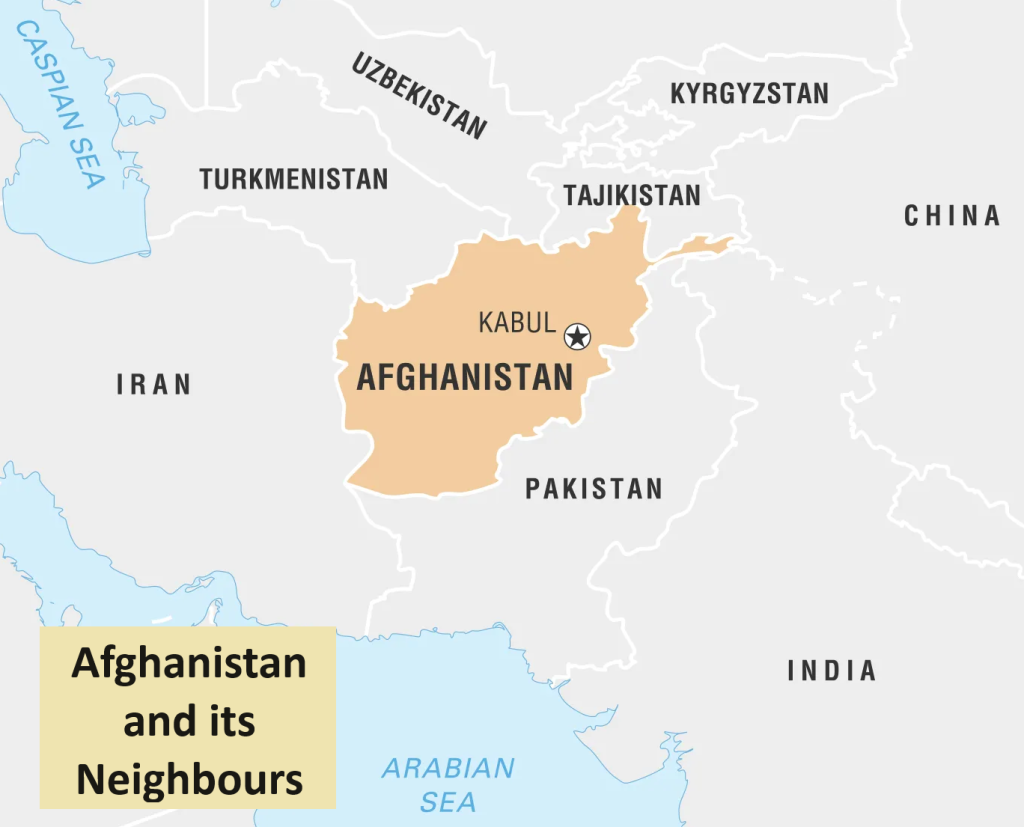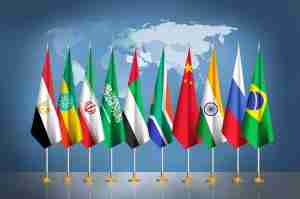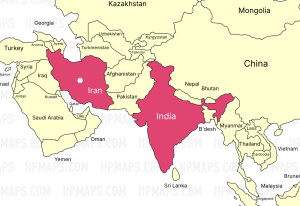1] Introduction

The return of the Taliban to power in August 2021 marked a dramatic shift in the regional dynamics of South and Central Asia. The security blanket of U.S./NATO forces that had kept extremist threats in check was withdrawn. For India, the takeover ended two decades of close ties with an elected Afghan government.
The sudden change pushed India to recalibrate its Afghan policy. The challenge was to safeguard Indian interests in the region while also upholding its stated commitment to democratic ideals and inclusive governance.
India’s core stakes in Afghanistan include ensuring strategic depth vis-à-vis Pakistan, preserving regional stability, advancing trade and connectivity to Central Asia, and bolstering counterterrorism efforts . The regime change put all of this at stake.
India’s initial response was one of caution – evacuating its mission and adopting a wait-and-watch stance. However, India has gradually transitioned to a strategy of cautious re–engagement: quietly reopening diplomatic channels, providing humanitarian aid, and engaging in regional dialogues, without extending formal recognition to the Taliban regime. This nuanced approach seeks to give India a “fighting chance” to secure its interests in Afghanistan, engaging the de facto authorities enough to remain relevant, but not legitimizing them.
This article explores how India is attempting to balance its principles and pragmatism in Afghanistan, and what the future may hold for this fraught relationship.
2] India’s Historical Engagement with Afghanistan
India’s relations with Afghanistan run deep. It has been shaped by cultural affinities and decades of development partnership. India was substantially involved in post-2001 Afghanistan, driven by soft power and development assistance.
India invested over $3 billion in infrastructure, humanitarian aid, and capacity building. Major projects included the Salma Dam, the Zaranj–Delaram Highway, the Afghan Parliament building, and medical missions, etc. India’s projects in Afghanistan were largely well-received and delivered on the ground, earning it substantial goodwill.
India consciously avoided military deployment, instead positioning itself as a benevolent partner. The 2011 Strategic Partnership Agreement formalised India’s role in training Afghan forces and rebuilding civilian infrastructure. Educational and cultural ties flourished, with over 65,000 Afghan students trained in India, and thousands of Afghans benefitting from ICCR scholarships and healthcare support. By 2021, India was seen as a trustworthy friend by Afghans, irrespective of ethnicity or ideology.
3] The Taliban Takeover and India’s Diplomatic Dilemma
The sudden collapse of the Afghan Republic in August 2021 forced India into crisis mode. It launched Operation Devi Shakti to evacuate Indian nationals, embassy staff, and vulnerable Afghan minorities (especially Hindus and Sikhs). India shut down all its diplomatic missions in Afghanistan and adopted a “wait-and-watch” policy.
This cautious approach was driven by India’s deep mistrust of the Taliban due to its ties with Pakistan and its past harbouring of anti-India terrorist groups. Meanwhile, Pakistan, China, Iran, and Russia swiftly moved to engage the Taliban, seeking influence in the new power vacuum. This diplomatically isolated India.
New Delhi faced a tough strategic choice: either continue isolating the Taliban at the risk of losing its strategic stakes, or begin pragmatic engagement while maintaining principled opposition to their ideology. Ultimately, India opted for a calibrated re-entry into Afghanistan without formal recognition.
4] India’s Post-2021 Engagement Strategy
“Engage, but do not endorse” – this phrase encapsulates India’s calibrated response to Taliban rule from 2021 till today. By mid-2022, India resumed limited engagement by deploying a “technical team” to its embassy in Kabul, ostensibly to coordinate humanitarian assistance. India made clear that this did not constitute recognition of the Taliban regime.
India’s approach unfolded along three main lines: humanitarian assistance, limited diplomatic re-engagement, and participation in regional dialogues.
India has consistently emphasized that its foremost priority is the welfare of the Afghan people. Thus, India delivered tonnes of wheat, COVID-19 vaccines, medical equipment and continued scholarships and online education for Afghan students and thus sustain its soft power links with ordinary Afghans,
New Delhi also offered emergency visas to persecuted Afghan Sikhs and Hindus, especially after ISIS-K (ISIS-Khorasan) attacks on minority places of worship.
India has also been active in regional dialogues—such as the Delhi Regional Security Dialogue, Moscow Format, and SCO meetings—India highlighted the risk of Afghanistan becoming a terror haven.
India has also consistently demanded that the Taliban form an inclusive and representative government and uphold women’s rights.
Overall, India’s engagement remains deliberately limited and non-committal. It deals with Taliban authorities functionally but without conferring legitimacy. For example, while India allowed Taliban appointees to operate consular services unofficially in Mumbai, it continues to avoid any formal recognition or diplomatic accreditation.
5] Strategic and Security Concerns
India’s security establishment views Taliban-led Afghanistan as a double-edged sword. On one hand, a hostile regime in Kabul aligned with Pakistan could pose grave threats to Indian security. There are fears that Taliban will once again become a sanctuary for anti-India terrorist groups like Lashkar-e-Taiba (LeT), Jaish-e-Mohammed (JeM), or even remnants of Al-Qaeda.
On the other hand, the Taliban’s own hostility towards ISIS-K and the emerging rifts with Pakistan create new paradoxical opportunities for India to find common cause with the Taliban in certain areas. For example, Taliban’s recent condemnation of the Pahalgam attack is a setback to Pakistan.
Taliban’s assurances on not allowing Afghan soil to be used for terrorism is perceived as ambiguous and insufficient by New Delhi . Therefore, New Delhi’s engagement has been calibrated – combining pressure with quiet dialogue . It aims to nudge the Taliban toward behaviours that align with India’s security interests. India is also building intelligence-sharing mechanisms with Russia, Iran, and Central Asia.
6] India–Pakistan Rivalry in the Afghan Context
Afghanistan remains an important theatre in the India–Pakistan rivalry. Initially, Pakistan celebrated the Taliban’s return. But their ties have since soured over the Tehrik-i-Taliban Pakistan (TTP) issue.
The TTP (often called the “Pakistani Taliban”) is an extremist group that wages insurgency against the Pakistani state. Its objective is to overthrow the elected government of Pakistan and establish an emirate based on its interpretation of Islamic law.
TTP has found safe haven in Taliban-ruled Afghanistan. The Taliban share similar ideology and thus they refused to crack them down on them despite Pakistani demands. This led to a surge in terrorist attacks on Pakistani soil. This has upset Pakistan.
Taliban’s refusal to acknowledge the Durand Line (the Afghanistan–Pakistan border) has exacerbated tensions between them. Taliban also actively opposed Pakistan’s attempts to fence it. Besides, Pakistan’s decision in late 2023 to expel over 1.7 million Afghan refugees sparked further bitterness.
This Taliban–Pakistan rift has opened strategic space for India. Furthermore, Taliban now sees India as an economic partner and counterbalance to Pakistan. They have requested more trade via Chabahar Port, air corridors, and Indian visas for Afghan businessmen.
India, while wary of over-investing, has used this window to regain relevance. It condemned Pakistan’s bombing of Afghan civilians. However, India remains cautious, aware that hardline factions within the Taliban still harbour hostility toward it.
7] Connectivity and Geoeconomics
India has long viewed Afghanistan as a land bridge to Central Asia. Projects like the Chabahar Port in Iran and the International North-South Transport Corridor (INSTC) were designed to bypass Pakistan and integrate Afghanistan into India’s strategic connectivity map.
After the Taliban takeover, Afghanistan’s interest in Chabahar and INSTC has grown. Frustrated with reliance on Pakistani ports, the Taliban have expressed strong support for using Chabahar and joining INSTC, indicating willingness to cooperate with India and Iran.
Apart from that, the Taliban have repeatedly expressed strong support for TAPI, which has been on hold for years due to security and financing issues. They are keen to earn transit fees and energy supply.
The geo-economics domain is one where India and the Taliban have cautiously found common interests. However, India is cautiously optimistic. Cooperation will depend on the broader political climate. Meanwhile, India supports community-level development projects and regional integration initiatives that align with its interests and Afghan economic needs.
8] Multilateral Diplomacy
To navigate the situation, New Delhi has actively engaged with a range of international and multilateral mechanisms. India’s multilateral strategy has two principal goals: providing humanitarian relief to the Afghan people and shaping international consensus on the Taliban (to pressure the regime toward desired norms).
To do so, India has leveraged forums from the United Nations to regional coalitions, often walking a tightrope between Western and regional approaches.
India has actively used multilateral platforms—UN, SCO, Moscow Format, and the G20—to shape global engagement with Afghanistan. In 2021, it co-authored UNSC Resolution 2593. This resolution – still a key benchmark– laid down the international community’s expectations: no terrorism emanating from Afghanistan, safe passage for those wishing to leave, and the formation of an inclusive government.
India also supported UN humanitarian coordination and channelled aid through agencies like WFP and WHO. It also worked closely with Russia, Iran, and Central Asian Republics to ensure that Afghanistan doesn’t descend into terrorism or civil war.
India has avoided recognising Taliban diplomats at the UN or in New Delhi but allowed limited consular representation, signalling tactical engagement without legitimacy.
9] Normative vs. Pragmatic Diplomacy
One of the most delicate aspects of India’s post-2021 Afghanistan policy has been balancing its normative commitments – support for democracy, pluralism, and human rights – with the pragmatic necessities of dealing with an illiberal regime in Kabul.
India often champions itself as a supporter of democratic values on the world stage and had been a staunch backer of the elected Afghan Republic. The Taliban’s ideology and track record (both in the 1990s and now) run directly counter to many of India’s professed principles: the Taliban have dismantled democratic institutions, trampled on women’s rights, and imposed a theocratic monopoly on power. This poses a moral dilemma for New Delhi.
Despite these articulated values, India has clearly adjusted its policy pragmatically to the on-ground reality of Taliban rule. The very act of re-engaging (sending diplomats back to Kabul, meeting Taliban ministers) is in some ways a deviation from India’s earlier normative stance of isolating the Taliban.
While India was once a vocal advocate for Afghan democracy, it now avoids using the term, focusing instead on stability, security, and humanitarian relief. Its practical dealings with the Taliban do imply normative compromises, but India frames them as necessary to protect the Afghan people and counter terrorism.
Thus, India’s diplomacy in Afghanistan represents realist engagement moderated by idealistic messaging, reflecting its broader foreign policy doctrine of strategic autonomy.
10] Future Outlook and Policy Options
India has three broad paths ahead. India can maintain status quo bycontinuing limited engagement with a technical mission and aid, but withhold recognition. This allows flexibility while maintaining moral high ground.
Secondly, India can look forward to gradual normalisation of ties. If Taliban improves on terror and human rights fronts (e.g., reopening girls’ schools, distancing from LeT/JeM), India could consider phased recognition and resume infrastructure projects.
The third approach would be that of deterioration and containment. If Afghanistan becomes a haven for anti-India terror or descends into chaos, India may revert to a containment policy—backing resistance forces, bolstering Kashmir security, and isolating the Taliban internationally.
India’s current course favours the first path, keeping engagement active but recognition deferred. It seeks to retain a role in Afghanistan’s future without compromising its values or security.
11] Conclusion
Afghanistan has been crucial in India’s foreign policy matrix. Thus, India must navigate the changing landscape cautiously. India should remain an active participant in the regional dynamics.
India’s strategy since the Taliban takeover reflects cautious pragmatism. While the Taliban’s rise was a setback, India has reinserted itself diplomatically and economically, largely through humanitarian means. It has maintained moral clarity, avoided legitimising an oppressive regime, and carefully balanced its interests with its ideals.
India remains committed to ensuring that Afghanistan does not become a threat to its security or a pawn in the China–Pakistan axis. Through limited engagement, backchannel diplomacy, and multilateral coordination, India hopes to shape Afghanistan’s future constructively—without endorsing its present rulers, but without abandoning its people either.















